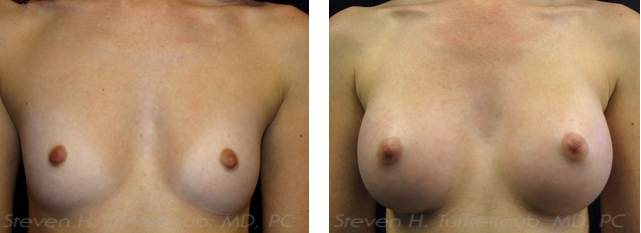Home|Blog | Breast Augmentation Incisions and Scar Visibility
Breast Augmentation Incisions and Scar Visibility
Any person who undergoes surgery WILL have scars afterward just by the nature of the wound healing process. Even with the most skilled of surgeons, scars form where incisions are placed though they may be quite inconspicuous. Women who undergo breast augmentation should expect post-surgical scars regardless of the incision they choose. While each incision location has its pros and cons, Dr. Turkeltaub recommends the inframammary incision for nearly all patients based on consideration of all factors—including scar visibility.
What to Expect for Surgical Scars
There are three well-accepted breast augmentation incision locations for breast implant insertion: inframammary, periareolar, and transaxillary. While some surgeons will imply that certain incisions have “less scarring” than others, the fact is that scarring is somewhat similar across the three incision locations. Scarring is more determined by your body’s ability to heal primarily and surgical expertise secondarily.
The conspicuousness of the scar is also influenced by its location and visibility and factors related to personal preferences. These locations include:
- Inframammary: The scar is located along the breast fold, underneath the breast.
- Periareolar: The scar is located on the lower half of the areola, along the outer border of the areola.
- Transaxillary: The scar is located within the fold of the armpit.
Choosing Your Incision Type
If avoiding surgical scars on the breasts is your main focus, you might choose the transaxillary incision since it is hidden in the armpit and not on the breast itself. However, by doing so, one is trading visibility for other increased risks that may significantly potentially outweigh this one positive benefit. Therefore, Dr. Turkeltaub strongly recommends that you consider all important factors and issues before deciding which incision approach is right for you.
Considering All Factors
Some of these other factors to consider besides “visibility” are limitations on implant type and size, risk of developing capsular contracture, implant malposition, loss of nipple sensation, contour irregularities, and asymmetries. In terms of overall risks, the inframammary incision is the clear winner here. This approach places no limitations on implant type, filling material, size, profile, or shape, which is in strong contrast to the periareolar and transaxillary incisions that cannot accommodate certain implants. Consequently, Dr. Turkeltaub recommends the inframammary incision for most of his patients.
Using very meticulous techniques, Dr. Turkeltaub strives to help you obtain the best scar possible no matter what location you choose. Postoperatively, you will also undergo a scar treatment protocol to help you realize this goal.
For more information, schedule your personal consultation by calling (480) 451-3000 or by completing our online contact form today.

